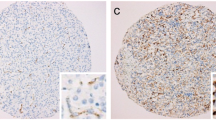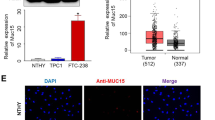Abstract
The truncated somatostatin receptor variant sst5TMD4 associates with increased invasiveness and aggressiveness in breast cancer. We previously found that sst5 activation may counteract sst2 selective agonist effects in a medullary thyroid carcinoma (MTC) cell line, the TT cells, and that sst5TMD4 is overexpressed in poorly differentiated thyroid cancers. The purpose of this study is to evaluate sst5TMD4 expression in a series of human MTC and to explore the functional role of sst5TMD4 in TT cells. We evaluated sst5TMD4 and sst5 expression in 36 MTC samples. Moreover, we investigated the role of sst5TMD4 in TT cells evaluating cell number, DNA synthesis, free cytosolic calcium concentration ([Ca2+]i), calcitonin and vascular endothelial growth factor levels, cell morphology, protein expression, and invasion. We found that in MTC the balance between sst5TMD4 and sst5 expression influences disease stage. sst5TMD4 overexpression in TT cells confers a greater growth capacity, blocks sst2 agonist-induced antiproliferative effects, modifies the cell phenotype, decreases E-cadherin and phosphorylated β-catenin levels, increases vimentin, total β-catenin and phosphorylated GSK3B levels (in keeping with the development of epithelial to mesenchymal transition), and confers a greater invasion capacity. This is the first evidence indicating that sst5TMD4 is expressed in human MTC cells, where it associates with more aggressive behavior, suggesting that sst5TMD4 might play a functionally relevant role.



Similar content being viewed by others
References
M.P. Pusztaszeri, M. Bongiovanni, W.C. Faquin, Update on the cytologic and molecular features of medullary thyroid carcinoma. Adv. Anat. Pathol. 21, 26–35 (2014)
S.A. Wells Jr, F. Pacini, B.G. Robinson, M. Santoro, Multiple endocrine neoplasia type 2 and familial medullary thyroid carcinoma: an update. J. Clin. Endocrinol. Metab. 98, 3149–3164 (2013)
C. Schreiber, K. Vormbrock, U. Ziebold, Genes involved in the metastatic cascade of medullary thyroid tumours. Methods Mol. Biol. 878, 217–228 (2012)
L. Santarpia, G.A. Calin, L. Adam, L. Ye, A. Fusco, S. Giunti, C. Thaller, L. Paladini, X. Zhang, C. Jimenez, F. Trimarchi, A.K. El-Naggar, R.F. Gagel, A miRNA signature associated with human metastatic medullary thyroid carcinoma. Endocr. Relat. Cancer 20, 809–823 (2013)
M. Ruscica, M. Arvigo, L. Steffani, D. Ferone, P. Magni, Somatostatin, somatostatin analogs and somatostatin receptor dynamics in the biology of cancer progression. Curr. Mol. Med. 13, 555–571 (2013)
M.C. Zatelli, D. Piccin, F. Tagliati, A. Bottoni, A. Luchin, C. Vignali, A. Margutti, M. Bondanelli, G.C. Pansini, M.R. Pelizzo, M.D. Culler, E.C. degli Uberti, Selective activation of somatostatin receptor subtypes differentially modulates secretion and viability in human medullary thyroid carcinoma primary cultures: potential clinical perspectives. J. Clin. Endocrinol. Metab. 91, 2218–2224 (2006)
J. Strosberg, L. Kvols, Antiproliferative effect of somatostatin analogs in gastroenteropancreatic neuroendocrine tumors. World J. Gastroenterol. 16, 2963–2970 (2010)
A. Rinke, H.H. Müller, C. Schade-Brittinger, K.J. Klose, P. Barth, M. Wied, C. Mayer, B. Aminossadati, U.F. Pape, M. Bläker, J. Harder, C. Arnold, T. Gress, R. Arnold, PROMID Study Group, Placebo-controlled, double-blind, prospective, randomized study on the effect of octreotide LAR in the control of tumor growth in patients with metastatic neuroendocrine midgut tumors: a report from the PROMID Study Group. J. Clin. Oncol. 27, 4656–4663 (2009)
M.E. Caplin, M. Pavel, J.B. Ćwikła, A.T. Phan, M. Raderer, E. Sedláčková, G. Cadiot, E.M. Wolin, J. Capdevila, L. Wall, G. Rindi, A. Langley, S. Martinez, J. Blumberg, P. Ruszniewski, CLARINET Investigators, Lanreotide in metastatic enteropancreatic neuroendocrine tumors. N. Engl. J. Med. 371, 224–233 (2014)
E. Mato, X. Matías-Guiu, A. Chico, S.M. Webb, R. Cabezas, L. Berná, A. De Leiva, Somatostatin and somatostatin receptor subtype gene expression in medullary thyroid carcinoma. J. Clin. Endocrinol. Metab. 83, 2417–2420 (1998)
G. Vitale, M. Caraglia, A. Ciccarelli, G. Lupoli, A. Abbruzzese, P. Tagliaferri, Current approaches and perspectives in the therapy of medullary thyroid carcinoma. Cancer 91, 1797–1808 (2001)
M.C. Zatelli, F. Tagliati, J.E. Taylor, R. Rossi, M.D. Culler, E.C. degli Uberti, Somatostatin receptor subtypes 2 and 5 differentially affect proliferation in vitro of the human medullary thyroid carcinoma cell line TT. J. Clin. Endocrinol. Metab. 86, 2161–2169 (2001)
M. Durán-Prado, M.D. Gahete, A.J. Martínez-Fuentes, R.M. Luque, A. Quintero, S.M. Webb, P. Benito-López, A. Leal, S. Schulz, F. Gracia-Navarro, M.M. Malagón, J.P. Castaño, Identification and characterization of two novel truncated but functional isoforms of the somatostatin receptor subtype 5 differentially present in pituitary tumors. J. Clin. Endocrinol. Metab. 94, 2634–2643 (2009)
M. Durán-Prado, A. Saveanu, R.M. Luque, M.D. Gahete, F. Gracia-Navarro, P. Jaquet, H. Dufour, M.M. Malagón, M.D. Culler, A. Barlier, J.P. Castaño, A potential inhibitory role for the new truncated variant of somatostatin receptor 5, sst5TMD4, in pituitary adenomas poorly responsive to somatostatin analogs. J. Clin. Endocrinol. Metab. 95, 2497–2502 (2010)
M. Durán-Prado, M.D. Gahete, M. Hergueta-Redondo, A.J. Martínez-Fuentes, J. Córdoba-Chacón, J. Palacios, F. Gracia-Navarro, G. Moreno-Bueno, M.M. Malagón, R.M. Luque, J.P. Castaño, The new truncated somatostatin receptor variant sst5TMD4 is associated to poor prognosis in breast cancer and increases malignancy in MCF-7 cells. Oncogene 31, 2049–2061 (2012)
M. Puig-Domingo, R.M. Luque, J.L. Reverter, L.M. López-Sánchez, M.D. Gahete, M.D. Culler, G. Díaz-Soto, F. Lomeña, M. Squarcia, J.L. Mate, M. Mora, L. Fernández-Cruz, O. Vidal, A. Alastrué, J. Balibrea, I. Halperin, D. Mauricio, J.P. Castaño, The truncated isoform of somatostatin receptor5 (sst5TMD4) is associated with poorly differentiated thyroid cancer. PLoS One 9, e85527 (2014)
M. Durán-Prado, M.D. Gahete, E. Delgado-Niebla, A.J. Martínez-Fuentes, R. Vázquez-Martínez, S. García-Navarro, F. Gracia-Navarro, M.M. Malagon, R.M. Luque, J.P. Castaño, Truncated variants of pig somatostatin receptor subtype 5 (sst5) act as dominant-negative modulators for sst2-mediated signaling. Am. J. Physiol. Endocrinol. Metab. 303, E1325–E1334 (2012)
L.H. Sobin, in TNM classification of malignant tumours, ed. by L.H. Sobin, M.K. Gospodarowicz, C. Wittekind (Wiley, Hoboken, 2009), p. 58
M. Andreoli, A new cell line for study of human medullary carcinoma, in Advances in thyroid neoplasia, ed. by S.S. Leong, J.S. Horoszewicz, K. Shimaoka (Field Educational, Rome, 1981), pp. 95–108
L.D. Cooley, F.F. Elder, A. Knuth, R.F. Gagel, Cytogenetic characterization of three human and three rat medullary thyroid carcinoma cell lines. Cancer Genet. Cytogenet. 80, 138–149 (1995)
M.C. Zatelli, F. Tagliati, D. Piccin, J.E. Taylor, M.D. Culler, M. Bondanelli, E.C. degli Uberti, Somatostatin receptor subtype 1 selective activation reduces cell growth and calcitonin secretion in a human medullary thyroid carcinoma cell line. Biochem. Biophys. Res. Commun. 297, 828–834 (2002)
M.C. Zatelli, F. Tagliati, J.E. Taylor, D. Piccin, M.D. Culler, E.C. degli Uberti, Somatostatin, but not somatostatin receptor subtypes 2 and 5 selective agonists, inhibits calcitonin secretion and gene expression in the human medullary thyroid carcinoma cell line, TT. Horm. Metab. Res. 34, 229–233 (2002)
M.C. Zatelli, M. Minoia, C. Martini, F. Tagliati, M.R. Ambrosio, M. Schiavon, M. Buratto, F. Calabrese, E. Gentilin, G. Cavallesco, L. Berdondini, F. Rea, E.C. degli Uberti, Everolimus as a new potential antiproliferative agent in aggressive human bronchial carcinoids. Endocr. Relat. Cancer 17, 719–729 (2010)
M.C. Zatelli, R. Rossi, E.C. degli Uberti, Androgen influences transforming growth factor-β1 gene expression in human adrenocortical cells. J. Clin. Endocrinol. Metab. 85, 847–852 (2000)
G.F. Taboada, R.M. Luque, W. Bastos, R.F. Guimaraes, J.B. Marcondes, L.M. Chimelli, R. Fontes, P.J. Mata, P.N. Filho, D.P. Carvalho, R.D. Kineman, M.R. Gadelha, Quantitative analysis of somatostatin receptor subtype (SSTR1-5) gene expression levels in somatotropinomas and non-functioning pituitary adenomas. Eur. J. Endocrinol. 156, 65–74 (2007)
A. Hamm, N. Krott, I. Breibach, R. Blindt, A.K. Bosserhoff, Efficient transfection method for primary cells. Tissue Eng. 8, 235–245 (2002)
D. Molè, E. Gentilin, T. Gagliano, F. Tagliati, M. Bondanelli, M.R. Pelizzo, M. Rossi, C. Filieri, G. Pansini, E.C. degli Uberti, M.C. Zatelli, Protein kinase C: a putative new target for the control of human medullary thyroid carcinoma cell proliferation in vitro. Endocrinology 153, 2088–2098 (2012)
M.C. Zatelli, D. Molè, F. Tagliati, M. Minoia, M.R. Ambrosio, E. degli Uberti, Cyclo-oxygenase 2 modulates chemoresistance in breast cancer cells involving NF-kappaB. Cell Oncol. 31, 457–465 (2009)
E. Gentilin, F. Tagliati, C. Filieri, D. Molè, M. Minoia, M.R. Ambrosio, E.C. degli Uberti, M.C. Zatelli, miR-26a plays an important role in cell cycle regulation in ACTH-secreting pituitary adenomas by modulating protein kinase Cδ. Endocrinology 154, 1690–1700 (2013)
T. Gagliano, C. Filieri, M. Minoia, M. Buratto, F. Tagliati, M.R. Ambrosio, M. Lapparelli, M. Zoli, G. Frank, E. degli Uberti, M.C. Zatelli, Cabergoline reduces cell viability in non functioning pituitary adenomas by inhibiting vascular endothelial growth factor secretion. Pituitary 16, 91–100 (2013)
A. Singh, J. Settleman, EMT, cancer stem cells and drug resistance: an emerging axis of evil in the war on cancer. Oncogene 29, 4741–4751 (2010)
J. Yang, R.A. Weinberg, Epithelial-mesenchymal transition: at the crossroads of development and tumor metastasis. Dev. Cell 14, 818–829 (2008)
L. Larue, A. Bellacosa, Epithelial–mesenchymal transition in development and cancer: role of phosphatidylinositol 3′ kinase/AKT pathways. Oncogene 24, 7443–7454 (2005)
J. Córdoba-Chacón, M.D. Gahete, M. Durán-Prado, R.M. Luque, J.P. Castaño, Truncated somatostatin receptors as new players in somatostatin-cortistatin pathophysiology. Ann. N. Y. Acad. Sci. 1220, 6–15 (2011)
M.C. Zatelli, D. Piccin, A. Bottoni, M.R. Ambrosio, A. Margutti, R. Padovani, M. Scanarini, J.E. Taylor, M.D. Culler, L. Cavazzini, E.C. degli Uberti, Evidence for differential effects of selective somatostatin receptor subtype agonists on alpha-subunit and chromogranin a secretion and on cell viability in human nonfunctioning pituitary adenomas in vitro. J. Clin. Endocrinol. Metab. 89, 5181–5188 (2004)
C. Rodríguez-Antona, I. Muñoz-Repeto, L. Inglada-Pérez, A.A. de Cubas, V. Mancikova, M. Cañamero, A. Maliszewska, A. Gómez, R. Letón, L.J. Leandro-García, I. Comino-Méndez, L. Sanchez, C. Alvarez-Escolá, J. Aller, A. Cascón, M. Robledo, Influence of RET mutations on the expression of tyrosine kinases in medullary thyroid carcinoma. Endocr. Relat. Cancer 20, 611–619 (2013)
J.J. Christiansen, A.K. Rajasekaran, Reassessing epithelial to mesenchymal transition as a prerequisite for carcinoma invasion and metastasis. Cancer Res. 66, 8319–8326 (2006)
A. Satelli, S. Li, Vimentin in cancer and its potential as a molecular target for cancer therapy. Cell. Mol. Life Sci. 68, 3033–3046 (2011)
V. Easwaran, S.H. Lee, L. Inge, L. Guo, C. Goldbeck, E. Garrett, M. Wiesmann, P.D. Garcia, J.H. Fuller, V. Chan, F. Randazzo, R. Gundel, R.S. Warren, J. Escobedo, S.L. Aukerman, R.N. Taylor, W.J. Fantl, beta-Catenin regulates vascular endothelial growth factor expression in colon cancer. Cancer Res. 63, 3145–3153 (2003)
Acknowledgments
We would like to that Michael D. Culler (Ipsen Biomeasure Inc., Milford, MA, USA) and Novartis Oncology (Italy) for providing the sst selective agonists and SOM230 (Pasireotide), respectively. We would like to thank Renzo Zatelli for the support in the statistical analysis. This work was supported by grants from the Italian Ministry of Education, Research and University (FIRB RBAP11884 M, RBAP1153LS, 2010TYCL9B_002), Fondazione Cassa di Risparmio di Ferrara, and Associazione Italiana per la Ricerca sul Cancro (AIRC) in collaboration with Laboratorio in rete del Tecnopolo “Tecnologie delle terapie avanzate” (LTTA) of the University of Ferrara, and by grants from BIO-139, CTS-1406 (Junta de Andalucía), BFU2013-43282 (MINECO/FEDER), PI13/00651 (Instituto de Salud Carlos III). CIBERObn es una iniciativa del Instituto de Salud Carlos III
Conflict of interest
The authors declare that they have no conflict of interest.
Informed consent
All patients provided informed consent for the study.
Author information
Authors and Affiliations
Corresponding author
Additional information
Daniela Molè and Erica Gentilin have contributed equally to this work.
Rights and permissions
About this article
Cite this article
Molè, D., Gentilin, E., Ibañez-Costa, A. et al. The expression of the truncated isoform of somatostatin receptor subtype 5 associates with aggressiveness in medullary thyroid carcinoma cells. Endocrine 50, 442–452 (2015). https://doi.org/10.1007/s12020-015-0594-x
Received:
Accepted:
Published:
Issue Date:
DOI: https://doi.org/10.1007/s12020-015-0594-x




